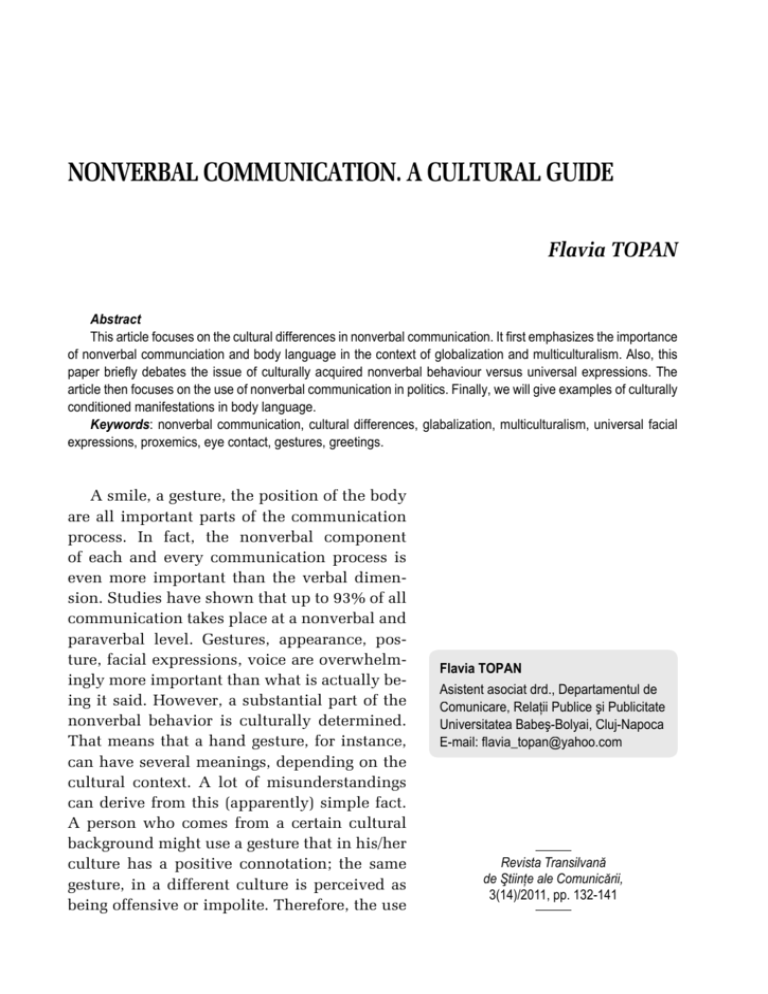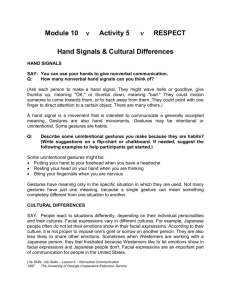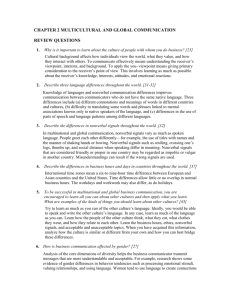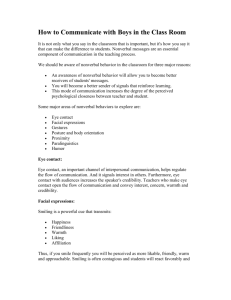nonverbal communication. a cultural guide
advertisement

NONVERBAL COMMUNICATION. A CULTURAL GUIDE Flavia TOPAN Abstract This article focuses on the cultural differences in nonverbal communication. It first emphasizes the importance of nonverbal communciation and body language in the context of globalization and multiculturalism. Also, this paper briefly debates the issue of culturally acquired nonverbal behaviour versus universal expressions. The article then focuses on the use of nonverbal communication in politics. Finally, we will give examples of culturally conditioned manifestations in body language. Keywords: nonverbal communication, cultural differences, glabalization, multiculturalism, universal facial expressions, proxemics, eye contact, gestures, greetings. A smile, a gesture, the position of the body are all important parts of the communication process. In fact, the nonverbal component of each and every communication process is even more important than the verbal dimension. Studies have shown that up to 93% of all communication takes place at a nonverbal and paraverbal level. Gestures, appearance, posture, facial expressions, voice are overwhelmingly more important than what is actually being it said. However, a substantial part of the nonverbal behavior is culturally determined. That means that a hand gesture, for instance, can have several meanings, depending on the cultural context. A lot of misunderstandings can derive from this (apparently) simple fact. A person who comes from a certain cultural background might use a gesture that in his/her culture has a positive connotation; the same gesture, in a different culture is perceived as being offensive or impolite. Therefore, the use 132 Flavia TOPAN Asistent asociat drd., Departamentul de Comunicare, Relaţii Publice şi Publicitate Universitatea Babeş-Bolyai, Cluj-Napoca E-mail: flavia_topan@yahoo.com Revista Transilvană de Ştiinţe ale Comunicării, 3(14)/2011, pp. 132-141 of nonverbal communication when dealing with people from different cultures is sometimes problematic. Knowing these cultural differences in nonverbal communication has become increasingly more important, especially in the context of globalization. People from different cultures and countries interact a lot more than our ancestors. Whether we are talking about business meetings, tourism, international programs or other forms of cultural interaction, knowing how the other cultures communicate (both verbal and nonverbal) is essential for establishing a solid relationship and it is, all in all, a form of showing respect for cultural diversity. Therefore, this paper will focus on pointing out the main differences between some cultures, speaking, mostly, from the point of view of nonverbal communication. However, the first levels of the argumentative structure will show the importance of the nonverbal factors of communication and some of the possible applications of the knowledge behind gestures and facial expressions. The forces of globalization bring people of different cultures closer together. Tourism, for example, is a flourishing new industry. People can travel to the most remote corners of the planet and encounter new cultures. Economy and international trade are more powerful than ever, and the increasing number of successful multinational companies only supplies an extra argument to support the unifying global tendencies. Moreover, international politics and diplomatic relationships between countries play a major role in shaping the world as we know it. With the boom in internet and mass media usage and with the expansion of intercultural exchanges, some researchers foresee that globalization will level out all cultural differences, thus creating a standardized “metaculture” that stretches across state borders and ethnic groups. On the other hand, multiculturalism can be seen as a form of resistance against the factors of globalization. It is due to the increased contact with other cultures, that we began to realize the immense cultural diversity the world has to offer. It is by comparing “us” with “the others” that we came to understand, appreciate our own cultural background and become more aware of cultural differences. No matter the causes of this phenomenon, facts are that we are living in a world in which civilizations collide more often than ever. Cultural belonging is important to all of us, that is why understanding and coming to respect cultural differences plays such an important role in international affairs. Being interconnected almost the entire time, cultural shock isn’t as strong as it once was – people generally know what to expect when travelling or doing business abroad. However, adjusting to another culture can prove to be a challenge: “cultural shock is experienced when you enter a culture from your home culture. Culture shock involves the frustration of not understanding verbal and communication, customs and the value system of the new culture.”1 Getting to know a new culture, understanding it and finally accepting it is a process that takes places in five stages. The first stage 1 Jeanette S. Martin, Lilian H. Chaney. Global Business Etiquette. A Guide to International Communications and Costums, Praeger, London, 2006, p. 10. 133 is also called “the honeymoon period”; the initial euphoria and enthusiasm about the new culture give the impression that everything is fascinating and the negative aspects are often ignored. The second stage marks the crisis – when the differences between the home culture and the new one seem impossible to overcome. This stage is usually made worse by home sickness and lack of friends. The next period is one of adjustment, when you begin to accept the new culture and take it for what it is, with its positive and negative aspects. The fourth stage, of acceptance, is marked by cultivating friendships, involvement in different activities and participating in social activities. The last stage, the reentry shock (when you return home) can be equally powerful, especially if the period spent abroad was long. Culture shapes the way people think, the way people act and the way people interact and communicate with each other and it does so from the moment we are born: “few of us are aware of our own cultural biases because cultural imprinting begins at a very early age. And though some of a culture’s values are taught explicitly, most are absorbed subconsciously. Often it is our lack of awareness and subconscious biases that create problems when we are trying to translate body language across cultures.”2 Furthermore, “each cultural world operates according to its own internal dynamic, its own principles, and its own laws – written and unwritten. Even time and space are unique to each culture.”3 Because nonverbal behavior has such a tremendous impact on the whole communication process it is vital to know and accept these differences in a multicultural environment. Nonverbal communication and paraverbal clues play a major part in the overall efficiency of the communication process. The verbal message is better perceived when the nonverbal language further emphasizes it. When there is a conflict between what is said and the way it is said, people usually believe what they see and not what they hear (even if they do so at a subconscious level). That being said, in the culturally diverse environment of today’s world, a single wrong gesture can ruin an entire relationship; and words, as we can see, don’t always have the strength to make things better. When dealing with body language there are some factors that should be taken in consideration before analyzing it. A single gesture is not necessarily relevant. Therefore, there are five factors that should be taken in consideration: context, clusters, congruence, consistency and culture – because “reading body language isn’t just about learning nonverbal signals; it is also about understanding how to get to the real meaning behind those signals.”4 Context refers to the circumstances in which the interaction takes place. Also clusters of nonverbal cues should be taken in consideration when analyzing body language: “a single gesture can have several meanings, but when you couple that single gesture with other nonverbal signals, 2 Carol Kingsey Goman. The Nonverbal Advantage. Berret – Koehler Publishers, Inc., San Francisco, 2008, p. 143. 3 Edward T. Hall, Mildreed Reed Hall. Understanding Cultural Differences. Intercultural Press, 1990, p. 3. 4 Carol Kingsey Goman. The Nonverbal Advantage. Berrett – Koehler Publishers, Inc., San Francisco, 2008, p. 19. 134 the meaning becomes clearer.”5 Congruence refers to the coordination between the verbal message and the nonverbal language because “when thoughts and words are in tune (that is, when people believe what they are saying), you see it corroborated with their body language. Their gestures and expressions are I alignment with what is being said.”6 Consistency is the relationship between the baseline behavior (under stress-free conditions) of a person and the changes that behavior suffers when the person is under stress. Finally, culture and cultural heritage have a great influence on all nonverbal communication. Universal versus culturally acquired nonverbal behavior Body language generally has a strong cultural connotation, because we acquire from an early age the correct and socially accepted behavior. However, there are some facial expressions that are so deeply rooted in our DNA that they are universal and go beyond cultural determination. Studies conducted by Professor Paul Ekman in the late 1950 showed that there are certain facial expressions (corresponding to certain emotions) that are the same for all the people, no matter their cultural background. He began his studies believing that gestures and body language in general were culturally conditioned, and therefore could be learned. His hypothesis later proved to be invalid, because the research he conducted in Papua New Guinea, Brazil, Japan, Argentina, the US or Indonesia proved that there are surprising similarities in how people express a set of basic emotions in all of these extremely different cultural regions. The new theory regarding the universality of some facial expressions was further demonstrated when Ekman applied his findings to a “Stone Age” culture from Papua New Guinea. These people, who had never seen outsiders before and hadn’t come in contact with any form of Western culture, expressed a set of basic emotions just as any American, European of Asian would do. There are six basic emotions that trigger these universal facial expressions: happiness, fear, surprise, anger, sadness and disgust/contempt. Even though these expressions are universal, people handle them in different manners, according to the culture they belong to. These display rules “are socially learned, often culturally different, rules about the management of expression, about who can show which emotion to whom and when they can do so. It is why in most public sporting contests the loser doesn’t show the sadness and disappointment he or she feels. Display rules are embodied in the parent’s admonition – “Get that smirk off your face.” These rules may dictate that we diminish, exaggerate, hide completely, or mask the expression of emotion we are feeling.”7 For instance, people from Asian cultures are more likely to mask a negative emotion with a smile than Americans or Europeans.8 5 Ibidem, p. 14. 6 Ibidem, p. 15. 7 Paul Ekman. Emotions Revealed. Recognizing Faces and Feelings to Improve Communication and Emotional Life, Times Books, 2003, p. 21. 8 Ibidem, p. 23. 135 Another argument to support the idea of universal emotions is the case of people who are born blind. If showing these emotions can be learned, how come people who are unable to see are capable of expressing the emotions stated above in the same manner as sighted people? These finding prove, once again, the importance of nonverbal communication across cultures. Facial expressions are more precise in telling how somebody is feeling: “Emotion messages can also be transmitted by the sound of the voice, body posture, hand/arm movements and leg/feet movements. But it is not certain whether they transmit information about emotion with as much precision as does the face.”9 Nonverbal communication in politics Probably the start off point of the use of nonverbal skills in politics was in 1960, in the US: “on 26 September 1960, 70 million U.S. viewers tuned in to watch Senator John Kennedy of Massachusetts and Vice President Richard Nixon in the first-ever televised presidential debate.”10 Nixon had injured his knee prior to the debate, he refused make up and he wore a shirt that didn’t fit him. On the other hand, Kennedy was fit, tanned and confident. The two candidates were evenly matched but “those who heard the first debate of the radio pronounced Nixon the winner. But the 70 million who watched television saw a candidate still sickly and obviously discomforted by Kennedy’s smooth delivery and charisma. Those television viewers focused on what they saw, not on what they heard.”11 When it comes to communication, people usually tend to believe their eyes and not what they hear. You can have a great speech, but if you deliver it in a dull and monotonous way people won’t listen to it. In politics, creating a bond of trust is crucial in order to gain votes. The body language of a candidate for a political function has to inspire trustworthiness, reliability, self confidence and honesty. Regardless the political orientation or the effectiveness of the measures advanced in the speech, if the candidate fails to deliver it accompanied by an open body language and if the verbal message is not entirely backed up by the nonverbal behavior, people will find it hard to trust that person. That is why you see politicians using gestures that suggest openness and honesty – such as palms facing upwards – or avoiding gestures that have a negative connotation, like palms facing downwards or crossed arms. The “science” behind nonverbal communication in politics also deals with posture, hand gestures, greetings, facial expression, even clothing and also with the paraverbal aspects such as tone, voice intensity or rhythm of speech. Of course, politics isn’t the only field where knowing the tricks behind body language is important. Understanding and using nonverbal communication is an effective way can have a positive impact in leadership, sales, business environment and even personal relationships. 9 Paul Ekman, Wallace Friesen. Unmasking the Face, Malor Books, Cambridge, 2003, p. 19. 10 Erika Tyner Allen. The Kennedy – Nixon Presidential Debates, 1960. www.museum.tv. 11 Ibidem. 136 To continue the argumentative structure of this paper we’ll briefly present in the following pages some differences in how some gestures are perceived, according to the cultural background. Eye contact Visual contact is an important part in the process of communication. However, different cultures have different views on eye contact and on its meanings. Generally, maintaining eye contact suggests self confidence and honesty, but there are some cultures that perceive prolonged eye contact as being impolite. Some cultures give more emphasis to eye contact than others. People from Germany, France, Greece, the Middle Eastern countries, for instance, are comfortable with a longer eye contact. By looking in the eyes of the person one is having a conversation with is a sign on attentiveness, respect, honesty and self confidence. On the other hand, by failing to look into somebody’s eyes can suggest shyness and lack of self confidence, but it can also trigger negative emotions because it can convey disrespect, dishonesty or inattentiveness. Avoiding eye contact might also point to a condescending attitude: “Failure to make eye contact in a culture that values it sends the message that the other person is insignificant and not worthy of recognition.”12 In contrast, people in Asian countries do not value eye contact as much as Westerners do. Direct eye contact is uncomfortable and is considered impolite: “China and Japan, specifically, tend to look just below the chin during conversations. They feel that not looking into the other person’s eyes shows respect.”13 Also, in some cultures, eye contact is connected to status and can be a reflection of power relationships. Usually, the person holding the superior position will engage in prolonged eye contact, while the subordinates are more likely to look away. Of course, there’s always another side to the issue of eye contact that is not necessarily linked to culture, but it has to do with interpersonal communication and building relationships. If a man and a woman are attracted to each other they will look at their partner for a longer period of time. Another indicator of attraction is pupil dilation. When looking at the person one is attracted to the pupils dilate. Also, if a person has dilated pupils he or she is more likely to be considered attractive by the opposite sex. Greetings The first impression is the one that lasts the long. Greeting somebody for the first time is a stepping stone for the entire relationship. Therefore, while dealing with somebody from a different cultural background it is essential to get acquainted with the proper introduction rituals. 12 Jeanette S. Martin, Lilian H. Chaney. Global... p. 56. 13 Ibidem, p. 57. 137 The most common greeting is the handshake but the way people shake hands may vary from one culture to another. For instance, men from Saudi Arabia shake hands by holding the other’s lower arm. The intensity of the hand shake can also be different according to the cultural background: Germans have a firm grasp, while the English shake hands gently. In other cultures, like the Asian cultures, it is common to bow when greeting somebody. Meanwhile, especially for the Japanese who work in international companies the handshake has become more acceptable. In order to show respect for both cultures, when introductions are made the bow is usually accompanied by a hand shake. In India, the most used form of greeting is by pressing one’s palms together, with the fingers up and placing the hands below the chin, accompanied by the word “Namaste” and a slight bow. However, there are some less conservative cultures that are more permissive to touch; people who live in these cultures usually greet each other by hugging, or in the case of women kissing on one or both cheeks. For instance, Russians are famous for their “bear hug” followed by a strong handshake. These greeting habits are also influenced, beyond the cultural factor, by the very nature of relationships that exist between the individuals who communicate. People who have stronger personal relationships are more likely to touch or hug than people greeting each other in business meetings. All in all, because the first impression has such a strong and persistent impact, no matter the social situation, one must try to get to know what are the customs and traditions of greeting someone from a different cultural background. Getting to know how people from another culture interact is the first step in building strong and stable relationships in that culture, especially when doing business with foreign companies. Space The use of space is closely linked to the way individuals greet each other for the first time. Usually, conservative cultures that are not so keen on physical contact and that use the bow, for example, while greeting someone, will tend to maintain a larger distance between speakers. Maintaining the socially accepted distance is very important because it means showing the proper respect to other person. Nevertheless, individuals from different cultures require different areas of comfort. Proxemics, or the use of space, is nothing else by the nonverbal manifestation of the territorial instinct that modern man inherits from his primitive ancestors. There are four main areas or types of distances. The first one, the intimate space is from our body and up to 45 cm around it. The second one is the personal area that stretches up to 1, 25 m, where communication with the people who are closer to us takes place. The social zone extends to 3.50 m, where there is no privacy left. Finally, the public area exceeds 3.5 m. usually in this area public communication takes place. However, these distances vary from culture to culture and invading somebody’s personal space can have a negative impact on the overall communication and 138 relationship building process. For instance, Italians “seem to stand in your space, continuously grabbing you, talking over the top of you, yelling in fact, and sounding angry about everything. But these things are a normal part of everyday friendly Italian communication. Not all things in all cultures mean the same things.”14 There are some factors that should be taken in consideration: “If you are a good communicator interculturally, you must adapt your communicator style as much as possible to the culture with which you are dealing. If you are dealing with a culture that seems unresponsive, cold, emotionless, or disinterested remember they might be showing you respect. Likewise, if you are dealing with a culture that is very emotionally demonstrative, you need to learn about their history, culture, and the way of life so you can participate in their enthusiasm for developing friendships so that you will be seen as a good working business partner.”15 Other aspects of the use of space include the way space is arranged. For instance, to display power individuals in high positions have their office at an upper floor of the building, usually with a massive desk opposite the window with a great view. Also, the way the furniture is positioned in a room can have a great deal of influence on the employees’ productivity. A round table usually encourages collaboration and suggests that all the members of the team are equals. Standing side by side, like in a waiting room will make communication harder. Gestures Hand gestures play an important role in the nonverbal communication. Sometimes a gesture can replace a word, like in the deaf mute language. Usually, a gesture has the purpose of emphasizing the verbal message. When failing to do so, or when the nonverbal language sends out a message that contradicts what the person is communicating through words, people are more inclined to believe the nonverbal dimension; people will believe what they see not what they hear. Congruence is an important factor in the process of communication: gestures should always reinforce the verbal message, in order to convey trustworthiness. Lie detection is based on the same principle of congruence or incongruence. When somebody is telling a lie “hotspots” are more likely to appear. These hotspots do not necessarily indicate that someone is not telling the truth but they can point out when there is a discrepancy between what a person is saying and what that person is conveying through body language. Usually these physical reactions are caused by the fact that telling a lie causes stress and that reflects in the way people gesticulate. Also, while researching facial expressions scientists have discovered that 14 Allan and Barbara Pease. The Definitive Book of Body Language. Pease International, 2004, p. 108. 15 Jeanette S. Martin, Lilian H. Chaney. Global... p. 73. 139 genuine emotions are very hard, if not impossible to fake. For instance, a genuine smile comes with the contraction of the muscles surrounding the eyes, causing small wrinkles around the eyes. If a person is faking or trying to hide an emotion, the facial expression won’t be as smooth as a natural and genuine one and usually it will be a little asymmetrical. Hand movements and gestures, however, can be strongly culturally determined. Some might have a positive meaning in some countries and a negative or vulgar meaning in others: “another gesture with a positive connotation is the thumbs-up signal. Although this gesture means “going good” or “everything is great” to people of most European countries and North America, it has a rude connotation in Australia and West Africa.” Another example of a gesture with several culturally determined meanings is the OK sign (thumb and forefinger joined to form a circle). This sign has a positive meaning in the US, but it’s considered obscene in Brazil. The same gesture means “worthless” to French people and in Japan it means money. Yet another example of culturally determined meaning is the way people say “yes”: for a Bulgarian shakings his head from left to right means “yes”, while in other countries the same gesture signifies the exact opposite. These are just a few examples of gestures that exist in various cultures but have totally different meanings according to the cultural context. Still, the examples mentioned above should be enough to prove the importance of knowing the customs and habits of other countries and other cultures: because you can do harm and offend other even without knowing; as we’ve seen in the previous examples, a positive gesture might be interpreted as offensive by people with a different cultural background. As we demonstrated so far, body language and nonverbal communication are key factors in all communication processes. Building a relationship relies on a good communication, but, according to the research in this area, about 93% of all human communication is nonverbal. Therefore, knowing the mechanisms behind it is useful for many reasons: it can help build stronger relationships, it can improve existing ones, it makes us more aware of what other are feeling and so on. Of course, this article did not intend to expose in an exhaustive manner all the cultural differences in nonverbal communication. Its purpose was to draw attention upon the importance of acknowledging these variations and respecting multiculturalism. For an expert in communication sciences knowing “the secrets” behind body language and understanding its power are crucial. But today’s communicators are players in a global market. Communication between cultures has gained more fluency and has grown in intensity. One of the reasons behind this phenomenon is that people nowadays travel more and interact with other cultures far more than our predecessors. Understanding the differences in nonverbal communication between cultures has a wide area of applications. Starting from building personal relationships with people from other cultures to closing international business deals or international communication campaigns, it all comes down to knowing the other culture and showing respect to its uniqueness. 140 Bibliography 1. Ekman, Paul. Emotions Revealed. Recognizing Faces and Feelings to Improve Communication and Emotional Life, Times Books, 2003. 2. Ekman, Paul, Friesen, Wallace. Unmasking the Face, Malor Books, Cambridge, 2003. 3. Hall, Edward T., Hall, Mildreed Reed. Understanding Cultural Differences. Intercultural Press, 1990. 4. Kingsey Goman, Carol. The Nonverbal Advantage. Berret – Koehler Publishers, Inc., San Francisco, 2008, p. 143. 5. Martin, Jeanette S., Chaney, Lilian H.. Global Business Etiquette. A Guide to International Communications and Costums, Praeger, London, 2006. 6. Pease, Allan and Barbara. The Definitive Book of Body Language. Pease International, 2004. 7. Tyner Allen, Erika. The Kennedy – Nixon Presidential Debates, 1960. www.museum.tv. 141









